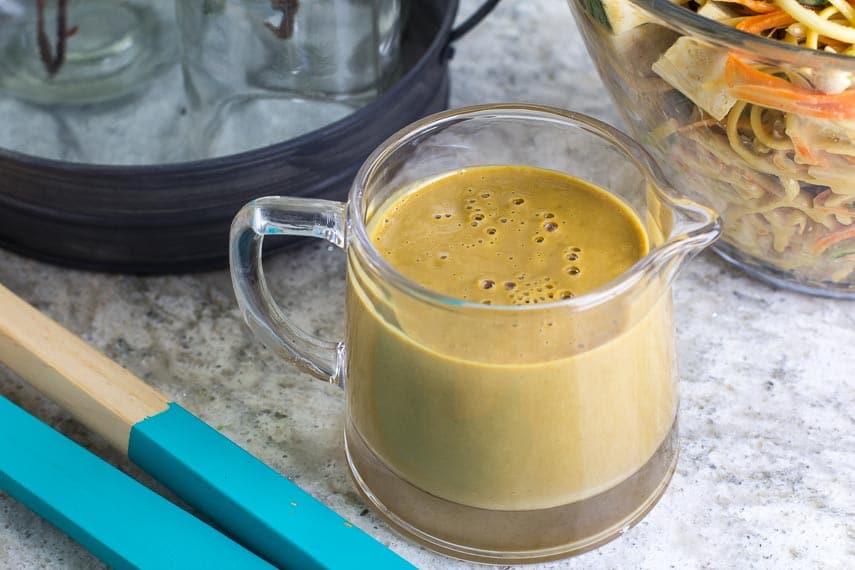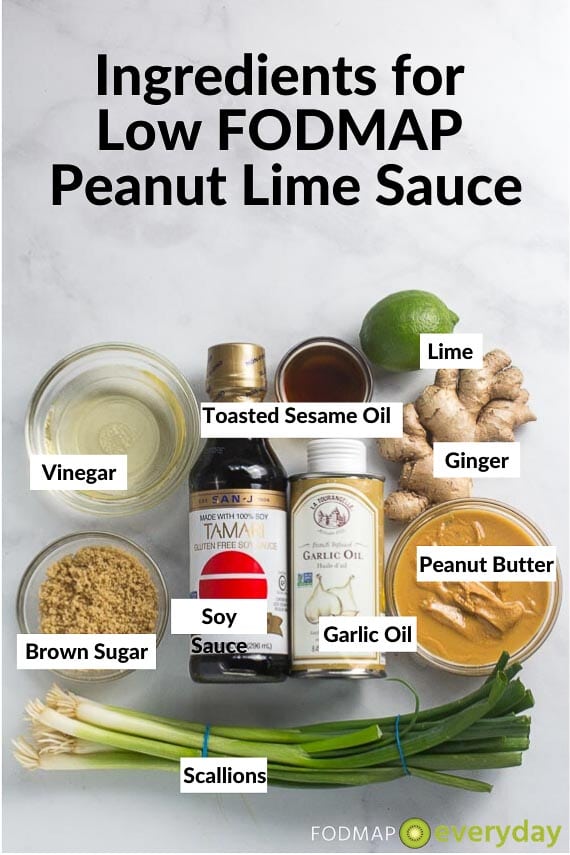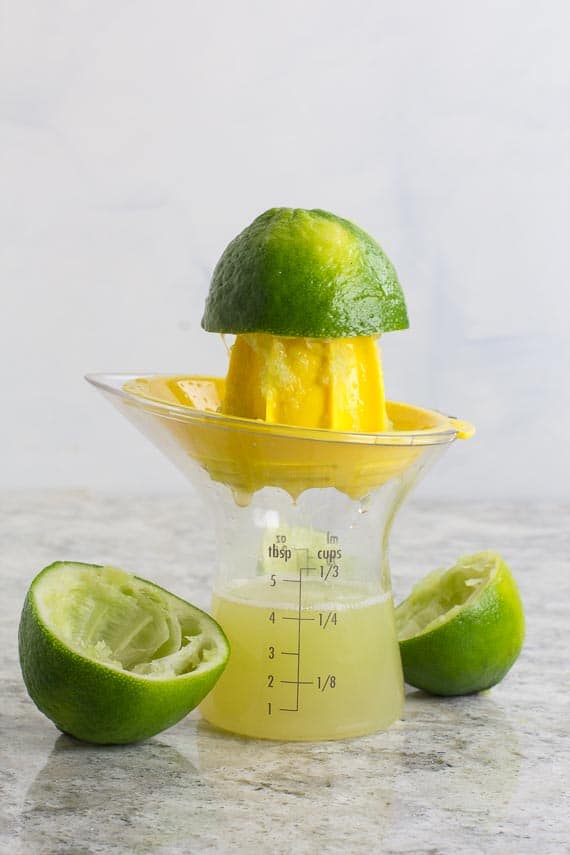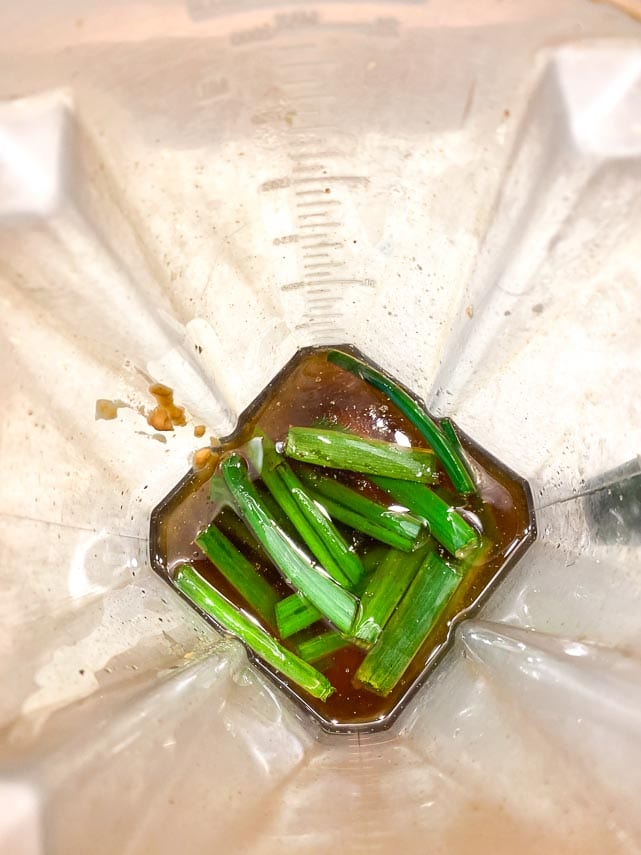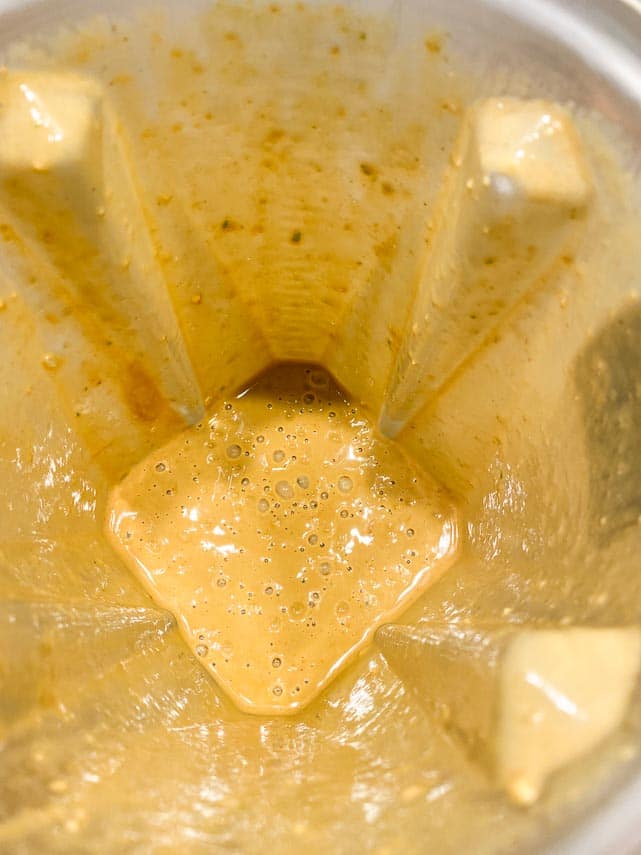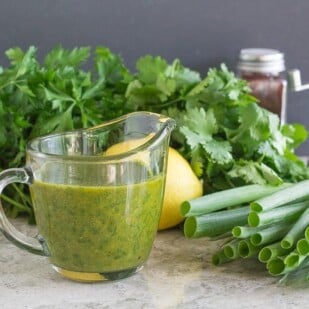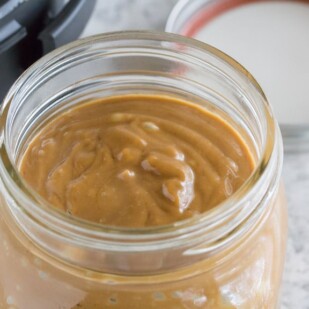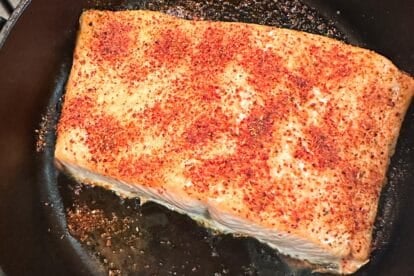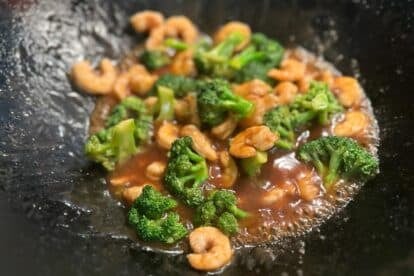Smooth, rich and tangy Low FODMAP Peanut Lime Sauce is very easy to make and we highly recommend it as a savory peanut butter-based sauce for your low FODMAP repertoire. Try it with our Low FODMAP Zoodles, Noodles & Sprouts Salad.
I am a huge fan of savory peanut butter sauces and our Garlicky Peanut Sauce was one of the first we brought to FODMAP Everyday®. This Low FODMAP Peanut Lime Sauce has less garlic flavor (although there is some) but it is ALL about the tangy lime!
One Sauce, Many Uses
This Low FODMAP Peanut Butter Lime Sauce has a fabulous tangy lime accent that you can use on vegetables, chicken, fish, tofu and meats, which means it is super versatile.
We particularly love it with our Low FODMAP Zoodles, Noodles & Sprouts Salad, seen in the background of the image below.
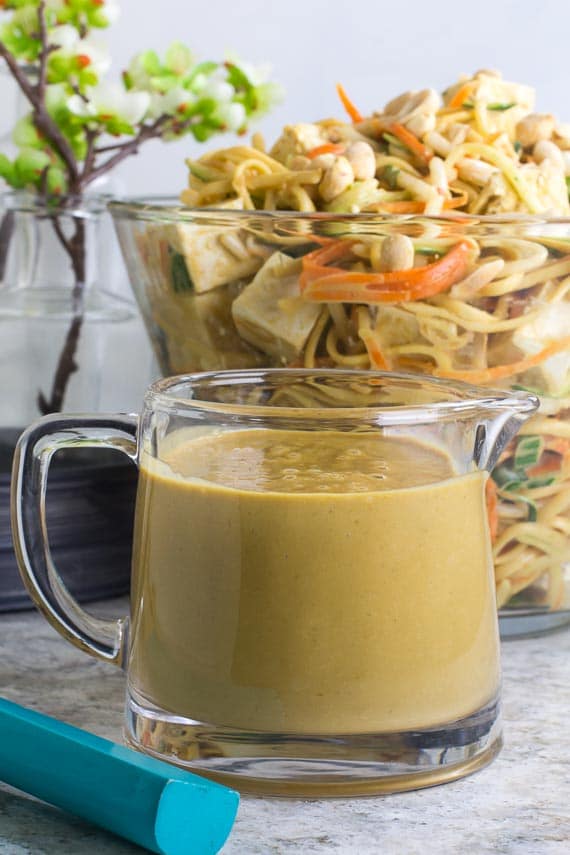
Convenience
It lasts, too. Make a double batch and keep some in the fridge for use later in the week, when you are hangry and NEED to eat NOW!
Grab a rotisserie chicken, some pre-shredded cabbage and toss together a simple main-dish salad that is a perfect support system for this sauce.
Our Low FODMAP Peanut Lime Sauce is even great as a dip for veggies for a quick LOFO snack!
About Chinese Black Vinegar
Chinese black vinegar has not been lab tested. It has a unique, rich, complex flavor that is very different from apple cider vinegar or rice wine vinegar. I always have some in the pantry and I know that I tolerate it well.
Please read our article, What If A Food Has Not Been Lab Tested For FODMAPs?
When I make this dish I use half rice wine vinegar and half Chinese black vinegar. If you are curious, try it yourself and see how you do! Maybe you will discover a new ingredient during your Challenge Phase.
Ingredients For Low FODMAP Peanut Butter Lime Sauce
You can see the ingredients needed in our image and I want to call your attention to the peanut butter and the limes in particular.
Garlic-Infused Oil – Made with vegetable oil. Not olive oil! You can make your own, which is very economical, or we like Tourangelle very much. I buy several at a time to have in the Test Kitchen pantry so that I am never without.
Soy Sauce – I am partial to San J Gluten-Free Reduced Sodium.
Vinegar – Try the black vinegar if you like or stick with strict low FODMAP and use the rice vinegar or apple cider vinegar.
Peanut Butter – I like to use natural peanut butter for this sauce, but NOT the kind that you grind in the store. I find that kind is always too coarse and dry. You can see from the image that mine is nice and moist. This one was from BJ’s Wholesale, but I often use Smucker’s.
Fresh Limes – You should use freshly squeezed lime juice for this sauce; it makes all the difference. Having a well-made reamer makes juicing the limes quick and easy. This one below is from Oxo and I love it. I can measure what I need as I work.
Toasted Sesame Oil – Makes sure you buy toasted sesame oil and not simply sesame oil. It should be a delectable looking mahogany brown as shown in the image.
Scallion Greens – As usual, scallion greens provide onion-esque flavor to our low FODMAP cooking. You can re-grow scallions in a glass!
Brown Sugar – Brown sugar is low FODMAP.
Fresh Ginger – Do not substitute ground ginger; use fresh ginger root for this sauce. Peel a hunk with a vegetable peeler and then just throw it in the blender.
How to Make Low FODMAP Peanut Butter Lime Sauce
You need a blender. I LOVE our Vitamix; it is a workhorse.
You simply add all the ingredients – in order listed – to a blender carafe, as seen above. You need the bulk of the liquid on the bottom to help it blend well.
Then just blend away! As stated above, if your peanut butter is not super dry, the texture should be fine without any added water, but feel free to add a little if needed to make a thick but flowable texture.
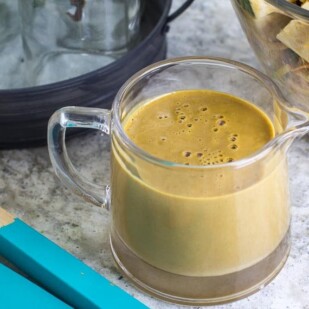
Low FODMAP Peanut Lime Sauce
Smooth, rich and tangy Low FODMAP Peanut Lime Sauce is very easy to make and we highly recommend it as a savory peanut butter-based sauce for your low FODMAP repertoire. Try it with our Low FODMAP Zoodles, Noodles & Sprouts Salad.
Low FODMAP Serving Size Info: Makes about 2 ½ cups ( ml); 8 servings; serving size ¼ cup (60 ml)
Ingredients:
- ½ cup (120 ml) Garlic-Infused Oil, based on vegetable oil, or purchased equivalent
- ½ cup (120 ml) low sodium, gluten-free soy sauce
- ½ cup (120 ml) apple cider or rice vinegar
- ½ cup (134 g) smooth peanut butter, either natural or no-stir style
- ¼ cup (60 ml) fresh squeezed lime juice
- ¼ cup (60 ml) toasted sesame oil
- 2 scallions, green parts only, roughly chopped
- 2 tablespoons firmly packed light brown sugar
- 2 tablespoons minced fresh peeled ginger
- Water, if needed
Preparation:
-
Place all the ingredients in a blender carafe in the order listed (you need a lot of liquid beneath the peanut butter to help it blend). Blend until super smooth, scraping down carafe as needed. Add water, a tablespoon at a time, to thin out, if needed. I usually do not need it; it is very dependent on the moisture level of your peanut butter. Sauce is ready to use or refrigerate in airtight container for up to 1 week.
-
It will thicken appreciably in the fridge. Bring back to room temp and/or re-blend and/or add a bit more water before using.
Notes:
Tips
When I made this for the first time I meant to add scallion greens, but forgot them - and the sauce was still delicious. So, you can leave them out or use them!
FODMAP Information
Our recipes are based on Monash University and FODMAP Friendly science.
- Garlic-Infused Oil: Make your own Garlic-Infused Oil or buy a commercial equivalent for the easiest way to add garlic flavor to your food. Fructans in garlic are not oil-soluble, so garlic-infused oil is low FODMAP.
- Ginger: Monash University has lab tested fresh ginger root and has determined it to be free of FODMAPs, making it one of our go-to no FODMAP foods.
- Lime Juice: Monash University has lab tested lime juice and it is low FODMAP in 1 cup (250 g) amounts (double that of lemon juice, as an interesting fact).
- Sugar: Monash University and FODMAP Friendly have both lab tested white, granulated sugar. Monash states that a Green Light low FODMAP serving size of white sugar is ¼ cup (50 g). FODMAP Friendly simply states that they have tested 1 tablespoon and that it is low FODMAP. Regular granulated white sugar is sucrose, which is a disaccharide made up of equal parts glucose and fructose. Sucrose is broken down and absorbed efficiently in the small intestine.
Please always refer to the Monash University & FODMAP Friendly smartphone apps for the most up-to-date lab tested information. As always, your tolerance is what counts; please eat accordingly. The ultimate goal of the low FODMAP diet is to eat as broadly as possible, without triggering symptoms, for the healthiest microbiome.
Nutrition
All nutritional information is based on third-party calculations and should be considered estimates. Actual nutritional content will vary with brands used, measuring methods, portion sizes and more. For a more detailed explanation, please read our article Understanding The Nutrition Panel Within Our Recipes.
